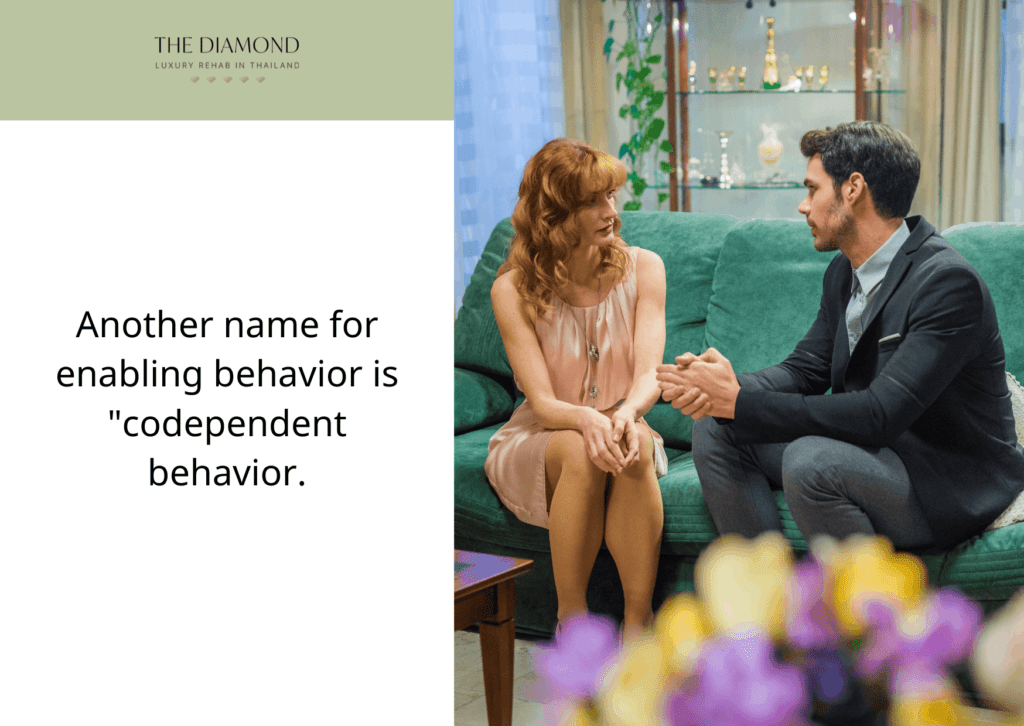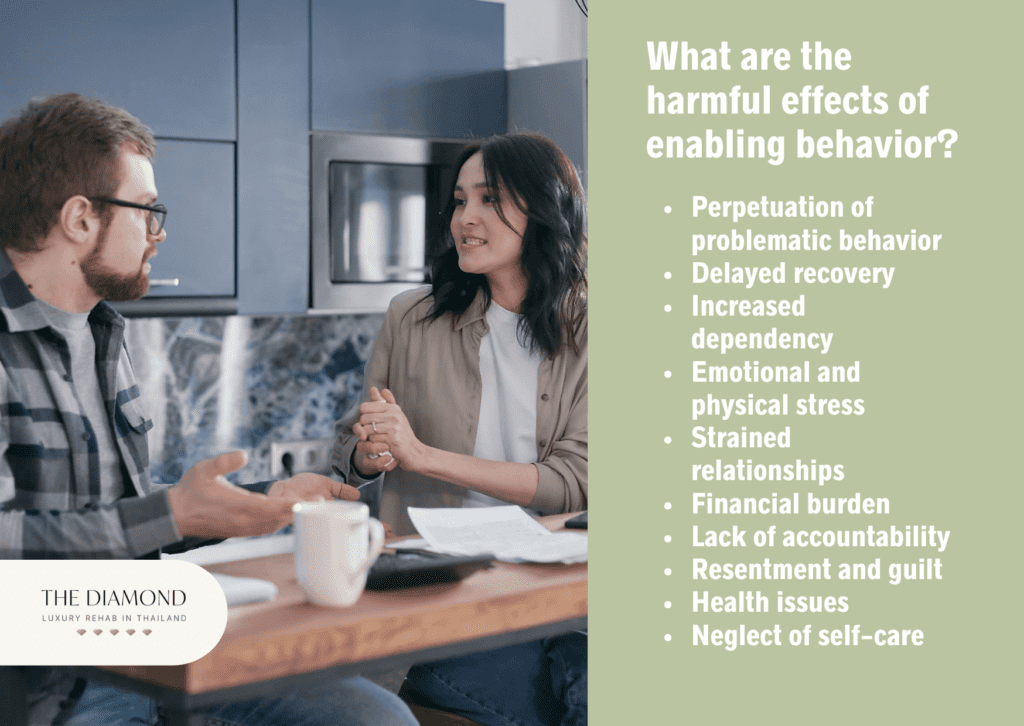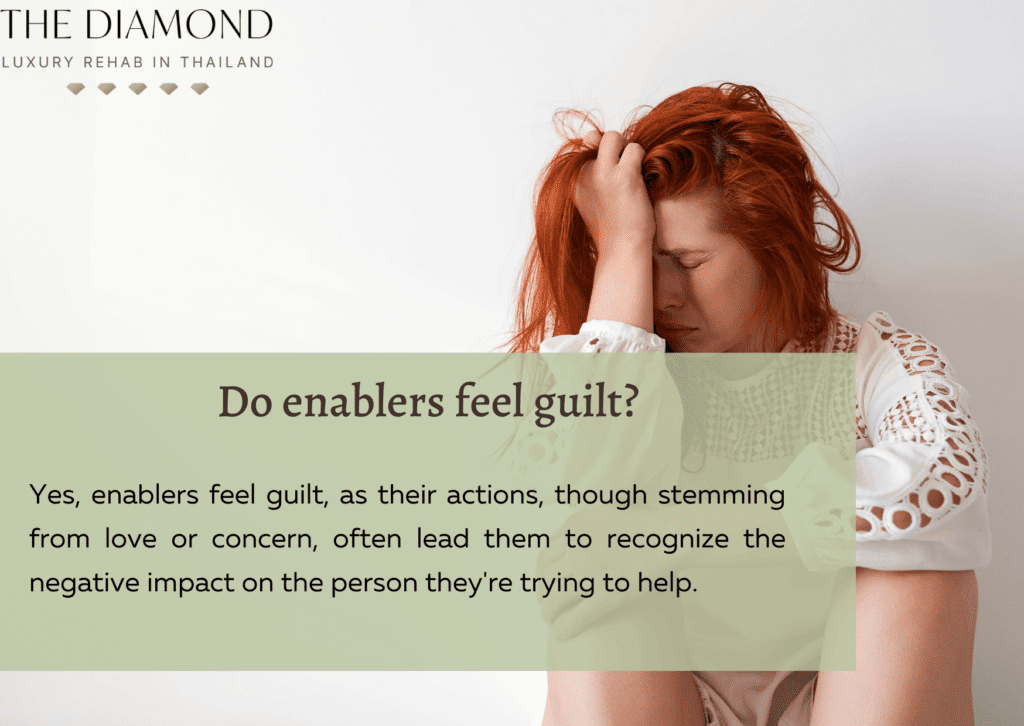Enabling behavior: definition, examples, and how to stop

Enabling behavior refers to actions taken by people that unintentionally support or perpetuate a loved one’s negative or harmful behaviors. People enable others out of guilt, fear, or pity, or because they want to avoid conflict. However, supporting someone’s negative behaviors unintentionally harms them by reinforcing unhealthy habits and hindering their ability to learn from their errors.
An enabler is a person whose supportive actions, driven by care, inadvertently perpetuate harmful or dysfunctional patterns in another individual. Their well-meaning efforts protect the individual from the consequences of their behavior, hindering personal growth and accountability.
Examples of enabling behavior encompass making excuses or justifying, denial, covering up, taking over responsibilities, financial support, avoiding conflict, minimizing, rescuing, blaming others, and emotional enabling.
To stop enabling behavior, address the issue directly, acknowledge the harmful actions, and insist on change. Encourage seeking help from a therapist, and set firm boundaries.
What is enabling behavior?
Enabling behavior refers to a process in which an individual, known as the enabler, unintentionally or passively helps another person continue engagement in maladaptive or harmful behaviors like substance abuse. According to the “APA Dictionary of Psychology” published in the American Psychological Association, last updated in April 2018, enablers are typically close friends or family members who, despite their desire to address and stop harmful behaviors, feel powerless to make a change. While trying to be supportive, their actions, such as making excuses or providing financial assistance, actually worsen the situation. The term “enabler” is often associated with negative judgment and stigma, as the enabler’s actions contribute to the persistence of harmful behaviors.
According to the research article “Enabling behavior in a clinical sample of alcohol-dependent clients and their partners” by Rob J Rotunda et al. published in the Journal of Substance Abuse Treatment in 2004, enabling behaviors are learned responses that influence substance use through reinforcement either positive or negative, increasing future likelihood of these behaviors.
A common example of enabling is seen when codependent spouses of alcoholics consider that they are helping by making excuses, covering up, or tidying up the clutter caused by their partner’s poor judgment. In reality, these actions often hurt rather than help, as they prevent the alcoholic from facing consequences and hinder psychological growth, while contributing to negative symptoms in the enabler.
What is another name for enabling behavior?

Another name for enabling behavior is “codependent behavior.” The concept of codependency, which first emerged in the 1940s to describe patterns exhibited by wives of alcoholics, is further explored in the article “The Lived Experience of Codependency: An Interpretative Phenomenological Analysis” by Ingrid Bacon et al. published in the International Journal of Mental Health and Addiction in 2018. The concept was further developed in the 1960s and 1970s by the Alcoholics Anonymous (AA) movement; it later expanded to encompass individuals closely connected to substance abusers, labeled as “enablers” or “coalcoholics.”
What are the causes of enabling behavior?
The causes of enabling behavior are listed below.
- Fear of conflict: Fear of conflict often drives enabling behavior. The prospect of confronting someone or having a tough conversation feels overwhelming, leading people to avoid potential arguments by turning a blind eye or covering up the problem. This avoidance is like tiptoeing around a landmine, hoping to escape an explosion. In enabling relationships, the desire to maintain peace overshadows genuine help, leading to a cycle where helping becomes more about avoiding discomfort than addressing the underlying issues. When assisting others starts to serve as a way to sidestep conflict or discomfort, it signals a shift from supportive behavior to enabling.
- Desire to help: The desire to help and support loved ones often backfires. When someone genuinely wants to assist another person, they end up enabling that individual’s harmful behaviors. This often happens when the help provided doesn’t address the root of the problem but rather allows the person to continue their destructive patterns.
- Guilt: Guilt is a powerful emotion that leads to enabling. If someone feels responsible for another person’s difficulties or believes they’ve failed them in some way, they overcompensate by enabling harmful behaviors. This attempt to alleviate their own guilt ultimately worsen the situation.
- Low self-esteem: Low self-esteem plays a significant role in enabling behavior. Those who struggle with their self-worth enable others as a way to feel needed or valued. By supporting someone’s negative behaviors, they find a sense of purpose or validation, even if it comes at a personal cost.
- Emotional dependence: Emotional dependence is another factor that drives enabling. When someone relies heavily on a relationship for their emotional well-being, they fear that confronting the other person or holding them accountable will jeopardize the relationship. This fear leads them to enable the problematic behaviors in order to maintain the emotional connection.
- Past experiences: Past experiences shape how people handle situations in the present. For few individuals, growing up in an environment where enabling was prevalent has influenced their current behavior. They unconsciously repeat these patterns, considering that enabling is a normal or necessary response.
- Misplaced compassion: Compassion is a noble trait, but it often has a misplaced meaning, that while having compassion is a commendable and virtuous quality, it is not always applied in the best way. When someone’s compassion leads them to overlook or excuse another’s harmful behavior, it results in enabling. This happens when the person’s good intentions end up reinforcing the negative behaviors instead of encouraging positive change.
- Denial: Denial about the severity of a problem leads to enabling. Minimizing the impact or expecting someone with addiction to act rationally blinds people to the need for change, preventing effective recovery steps. Blaming oneself or overlooking the true nature of their behavior are forms of denial.
- Control issues: For certain people, enabling is a way to exert control. By accommodating or making excuses for another’s behavior, they feel a sense of power or influence. This need for control leads to enabling, as it allows them to maintain a level of dominance over the situation.
- Cultural or social expectations: Cultural and social expectations contribute to enabling behavior. In certain cultures, there’s a strong emphasis on family loyalty or support, regardless of the circumstances. These societal norms pressure individuals to enable others, even when it’s not in anyone’s best interest.
- Lack of knowledge: A lack of understanding about what constitutes enabling leads people to inadvertently support harmful behaviors. Without proper knowledge about the impact of enabling and the importance of setting boundaries, individuals unknowingly reinforce negative patterns.
- Fear of abandonment: Fear of abandonment drives someone to enable another person’s behavior. The anxiety that confronting the problem leads to rejection or the end of the relationship causes them to avoid addressing the issue, thereby enabling the harmful behavior to continue.
- Emotional blackmail: Lastly, emotional blackmail is a significant cause of enabling behavior. When someone uses emotional manipulation to get their way, it coerces others into enabling their behavior. The fear of emotional repercussions or manipulation lead individuals to support harmful actions just to avoid conflict or maintain the relationship.
What are the harmful effects of enabling behavior?

The harmful effects of enabling behavior are listed below.
- Perpetuation of problematic behavior: Enabling behaviors unintentionally sustain harmful behaviors and patterns. For example, offering financial support fuels addictions such as substance abuse, alcohol misuse, or gambling. By covering legal fees or bailing someone out, one protects them from experiencing the full impact of their actions, which reduces their incentive to make changes.
- Delayed recovery: Enabling behavior significantly delays recovery from addiction or harmful behaviors by shielding individuals from the consequences of their actions. This prevents them from confronting their issues directly, recognizing the need for change, and seeking help.
- Increased dependency: Enabling fosters a cycle of dependency, where the individual relies increasingly on the enabler. This inturn hinders their development of independent coping skills and inability to take responsibility for their actions, potentially leading to an inability to function on their own.
- Emotional and physical stress: According to the research article “Enabling Behavior in a Clinical Sample of Alcohol-Dependent Clients and Their Partners” by Rob J. Rotunda et al. published in the Journal of Substance Abuse Treatment in 2004, living with a substance abuser leads to significant psychological and physical health issues for their partner. The enabler experiences a range of emotions, including anger, fear, frustration, depression, worry, helplessness, shame, and guilt. This constant emotional strain results in physical problems such as exhaustion, sleep disturbances, and increased susceptibility to illness. These challenges not only affect the enabler’s overall well-being but complicate the recovery process for everyone involved.
- Strained relationships: Enabling behavior creates significant strain within families and social circles. When one person consistently supports another’s harmful habits, it leads to resentment and conflict among other loved ones who don’t understand why these behaviors are being tolerated. This results in high levels of tension and discord within the family as they grapple with the negative consequences of the substance use disorder.
- Financial burden: Financial strain occurs when enablers bear the burden of supporting someone’s harmful habits, such as addiction. This support includes covering costs related to substance abuse, legal fees, or daily expenses. Over time, the financial resources of the enabler become depleted, leading to significant stress and hardship. This strain not only affects the enabler’s financial stability but strains relationships and reduces the enabler’s ability to invest in their own well-being and future.
- Lack of accountability: Enabling behavior undermines personal accountability and fosters dependency. By shielding individuals from the consequences of their actions, enablers create a cycle where they never fully experience the negative impacts of their choices. This lack of accountability prevents individuals from learning from their mistakes and developing the necessary skills to overcome their challenges.
- Resentment and guilt: Guilt and resentment often arise in enablers who struggle with the consequences of their actions. Parents, in particular, feel guilty and blame themselves for their child’s problems. Enablers regret not setting boundaries or enabling harmful behaviors, feeling complicit in the individual’s struggles. This guilt, combined with a sense of responsibility and ongoing support, lead to resentment, impacting the enabler’s emotional health and relationships.
- Health issues: Enabling takes a significant toll on the enabler’s health. The chronic stress of managing the consequences of another person’s harmful behaviors manifests as physical ailments such as high blood pressure and heart disease. Enabler’s health is significantly impacted by the demands of caregiving. The research article “Physical and Mental Health Effects of Family Caregiving” by Richard Schulz and Paula R. Sherwood, published in The American Journal of Nursing in 2008, highlights that factors such as the care recipient’s behavior problems, cognitive decline, and physical limitations contribute to the enabler’s stress. The duration and intensity of care, along with the caregiver’s age and relationship to the care recipient, further influence their overall well-being.
- Neglect of self-care: When individuals focus on supporting someone else’s harmful behaviors, they often neglect their own physical and emotional needs. This neglect leads to deteriorating health, increased stress, and diminished quality of life.
- Erosion of boundaries: When enablers consistently support or cover for someone’s harmful behaviors, it often leads to blurred or diminished personal boundaries. This erosion creates unhealthy dynamics where enablers feel obligated to continue providing support, even when it is detrimental to their own well-being.
- Hindered personal growth: Enabling behavior hinders personal growth by preventing individuals from developing essential life skills. When someone consistently rescues another from difficulties, it stops them from learning important lessons. For example, if a parent always bails out their adult child financially, the child never learns to manage money wisely. This limits their personal development, making them dependent on the enabler and preventing growth in areas like problem-solving and responsibility. Enabling behavior traps people in a cycle of dependence, hindering their ability to handle life’s challenges independently.
What are the examples of enabling behavior?
The examples of enabling behavior are listed below.
- Making excuses or justifying: Protecting loved ones from negative consequences often leads to enabling behavior. It’s natural to shield them from judgment by making excuses for their actions. However, this approach hinders their growth. Enabling occurs when you justify or support harmful behaviors under the guise of helping. This includes actions like providing financial assistance to a financially irresponsible loved one or making excuses for someone’s anger issues.
- Denial: Confronting addiction is challenging due to denial or resistance from a loved one. Their refusal to acknowledge the problem or unwillingness to change is a clear sign that their substance use is negatively impacting the relationship. It’s important to express concerns clearly, encourage them to seek treatment, and be ready to face the consequences of their behavior. At the same time, finding support through groups is beneficial.
- Covering up: Covering up involves concealing a loved one’s harmful behaviors to avoid conflict or negative consequences. This often stems from fear of their reaction if confronted or worry that they will withdraw affection or support if the enabler stops covering for them. The enabler accepts that exposing the truth damages the relationship or leads to rejection, making it challenging to address the underlying issues directly.
- Taking over responsibilities: Taking over responsibilities is a common form of enabling behavior. Examples include an enabler consistently completing a coworker’s portion of a project to avoid causing conflict with their colleagues. This behavior prevents the individual from experiencing the negative consequences of their actions and reinforces their reliance on the enabler.
- Financial support: Providing money or covering costs for someone enables them to persist in harmful behaviors such as substance abuse or gambling. When enablers cover expenses, they prevent the individual from experiencing the financial repercussions of their actions. This support perpetuates harmful behavior because the individual does not face the natural consequences, which otherwise motivate them to seek help or make changes. For example, paying for rehab or debts related to addiction temporarily solves problems but does not address the root cause of the addiction.
- Avoiding conflict: Steering clear of discussions or confrontations about the individual’s harmful behaviors avoids uncomfortable or confrontational situations. This approach prevents necessary accountability and problem-solving, allowing the harmful behaviors to continue unchallenged. By avoiding these discussions, enablers reinforce the behavior, as the individual does not receive the feedback or pressure needed to recognize and address their issues. This avoidance creates a false sense of normalcy and prevents the individual from seeking the help they need.
- Minimizing: Downplaying the severity of the individual’s issues or making excuses for their actions makes their problems appear less serious than they are. This behavior delays the recognition of the true extent of the issues and hinder timely intervention. For example, an enabler dismisses signs of a serious substance use disorder by saying the individual is just going through a rough patch, thereby preventing them from seeking appropriate help or treatment.
- Rescuing: Intervening to fix problems or cover up mistakes for the individual shields them from facing the natural consequences of their actions. This behavior prevents the individual from learning from their mistakes and taking responsibility for their actions. For example, if someone repeatedly makes poor financial decisions due to gambling and an enabler consistently bails them out, the individual does not experience the full impact of their behavior, which otherwise prompts them to change.
- Blaming others: Attributing the individual’s problems to external factors or other people deflects responsibility from them. This behavior hinders the individual’s ability to take ownership of their actions and address their behavior. For instance, if an enabler blames the individual’s substance abuse on stressful work conditions rather than acknowledging the addiction itself, the individual is less likely to confront their problem directly and seek appropriate help.
- Emotional enabling: Providing excessive emotional support that reinforces the individual’s dependence discourages them from seeking necessary help or making changes. When enablers continually offer comfort and reassurance without setting boundaries, they inadvertently encourage the individual to rely on them for emotional support rather than addressing their issues independently. For example, constantly providing emotional support without encouraging the individual to seek therapy or other forms of help maintain their reliance on the enabler, thus stalling personal growth and recovery.
How to stop enabling behavior?
To stop enabling behavior, begin by bringing attention to the issue at hand. Acknowledge the harmful behaviors of your loved one instead of ignoring or minimizing them. Clearly communicate that you recognize their substance misuse or other problematic actions and assert that these behaviors are unacceptable. Offer compassion, but make it clear that change is necessary. Encourage them to seek help, understanding that they resist or refuse treatment initially. Multiple discussions are needed, and working with a therapist for yourself provides strategies for approaching these conversations effectively.
Set and uphold firm boundaries to avoid enabling. For example, provide transportation to appointments but refuse to cover expenses like rent or legal fees. It’s important to assertively say no when necessary, even if it leads to conflict or anger. Assertiveness is crucial in maintaining boundaries and avoiding enabling behaviors.
What is an enabler?

An enabler is typically a close individual who inadvertently supports another person’s harmful behaviors. By shielding them from the consequences of their actions, enablers contribute to the continuation of these self-destructive patterns.
In the research article “Social Supporters and Drug Use Enablers: A Dilemma for Women in Recovery” by Gregory P. Falkin and Shiela M. Strauss, published in the journal Addictive Behaviors in 2003, it was found that for the women, partners acted as enablers of their drug use. Despite providing some level of social support, these partners often contributed to the women’s ongoing substance use.
Who is most likely to be an enabler?
An enabler is most likely to be a close individual, such as a family member or partner or adult children. This is due to their deep emotional bonds and sense of responsibility for their loved one’s well-being. They engage in enabling behaviors out of love, guilt, or a desire to avoid conflict, often believing they are helping by covering up or making excuses for the loved one’s harmful actions.
Close relationships, such as those with family members or partners, lead individuals to engage in enabling behavior. This attachment causes them to overlook or excuse problematic behavior to maintain harmony or avoid conflict. According to the article “Enabling Behavior in a Clinical Sample of Alcohol-Dependent Clients and Their Partners” by Rob J. Rotunda et al. published in the Journal of Substance Abuse Treatment in 2004, emotional attachment drives enablers to protect their loved ones from the consequences of their actions.
How does a person become an enabler?
A person becomes an enabler through a combination of psychological, emotional, and relational factors. Enabling typically arises from a deep-seated desire to protect or support a loved one, often leading to behaviors that inadvertently perpetuate harmful actions. Enablers are often motivated by a complex interplay of care, fear, and personal needs, which are intensified by societal expectations, particularly for women. Enablers usually act with good intentions, aiming to help rather than cause harm. However, what appears as supportive behavior actually reinforces the problem.
Psychologically, factors such as codependency, low self-esteem, and fear of conflict play significant roles. Codependent individuals rely on helping others to feel valued, while those with low self-esteem avoid confrontation to seek approval. These psychological traits often drive individuals to engage in enabling behaviors.
Relational dynamics further contribute to enabling. Caregiving roles, dysfunctional family patterns, and power imbalances reinforce enabling behaviors, making it challenging to establish healthy boundaries. Situational factors, including crises, feelings of guilt, and a lack of clear boundaries, exacerbate the issue, leading individuals to inadvertently support problematic behaviors. Importantly, enabling tends to develop gradually and unconsciously, underscoring the need to recognize these underlying factors to break the cycle and promote healthier relationships.
What are the common traits of enablers?
The common traits of enablers are listed below.
- Low self-esteem: Enablers often derive their sense of self-worth from their ability to help others, particularly by solving problems or managing crises. This external validation becomes a way of compensating for their own feelings of inadequacy. They prioritize others’ needs over their own to feel valued, even if it means neglecting their own health or well-being.
- Avoiding conflict: To avoid unpleasant confrontations and maintain a sense of harmony, enablers sidestep discussions about problematic behaviors. This avoidance prevents necessary accountability and resolution, allowing harmful behaviors to persist unchecked. Their reluctance to engage in conflict inadvertently reinforces the negative behavior by avoiding the discomfort of direct confrontation.
- Difficulty setting boundaries: Enablers often struggle with setting and maintaining clear boundaries due to a fear of rejection or anger. This difficulty in establishing limits leads to them tolerating or even facilitating problematic behaviors. Without firm boundaries, they inadvertently allow the individual to continue their harmful actions without facing appropriate consequences.
- Over-responsibility: Enablers frequently take on more than their fair share of responsibilities, including managing the fallout of someone else’s behavior. They handle financial issues, cover up mistakes, or take on additional tasks to compensate for the individual’s failures. This over-responsibility leads to burnout and neglect of their own needs, contributing to a stressful and imbalanced life.
- People-pleasing: Enablers often have a strong desire to please others and avoid disapproval, which drives them to go to great lengths to ensure others are happy or content. This tendency leads them to overlook or dismiss their own needs, preferences, and well-being in favor of accommodating the other person’s desires or demands.
- Lack of self-care: Prioritizing the needs of others over their own often results in enablers neglecting their personal well-being. They forgo self-care activities, health maintenance, and personal interests to focus on the needs of the person they are enabling. This neglect leads to physical and emotional health issues, diminishing their overall quality of life.
Do enablers feel guilt?

Yes, enablers feel guilt, as their actions, though stemming from love or concern, often lead them to recognize the negative impact on the person they’re trying to help. This realization leads to feelings of guilt, regret, and even self-blame. It’s important to remember that enablers are often caught in a complex dynamic and need support to break free from the cycle.
Individuals with codependent tendencies often prioritize the needs and behaviors of others over their own. This preoccupation frequently stems from low self-esteem and a pervasive desire for external validation. In conflicts, they assume a victim role, and even when asserting their boundaries, they often experience guilt. This pattern of self-sacrifice and people-pleasing significantly impact their overall well-being.
How can one avoid becoming an enabler?
One can avoid becoming an enabler through a combination of self-awareness, clear boundaries, and maintaining a focus on both personal well-being and the well-being of the person being cared for. Recognize patterns and motivations for helping others, especially if they stem from codependency, low self-esteem, or fear. Prioritize self-care to maintain emotional and mental well-being, which facilitates effective boundary-setting. Educate oneself about enabling behaviors, addiction, and mental health to better understand the dynamics at play.
Establish clear limits on what will be done for the other person and communicate concerns and feelings honestly and assertively. Practice saying no to requests or offers of help that do not align with one’s best interest, and be prepared to enforce consequences if boundaries are violated.
Focus on the long term by encouraging the person to take responsibility for their actions and develop problem-solving skills. Promote seeking professional assistance if necessary, and practice detaching with love—caring for the person without enabling harmful behaviors. Implementing these strategies helps foster healthier relationships while avoiding the pitfalls of enabling behavior.
How does a person handle an enabler?
A person handles an enabler by first recognizing the signs of enabling in the relationship. Begin by openly addressing the harmful behaviors, expressing concerns with both compassion and clarity. Encourage the loved one to seek professional help, while being prepared for possible resistance.
It’s important to directly address an enabler’s harmful behavior and how they contribute to addiction. Providing specific examples of the negative impact on the addict helps highlight the harmful consequences. Clear communication that avoids blaming often encourages a shift towards more supportive behavior. Once enablers realize how their actions perpetuate addiction, they are often willing to change and become a positive influence.
Establish clear boundaries and adhere to them consistently, prioritizing personal well-being by learning to say no and seeking therapy if necessary. If substance abuse is involved, create a substance-free environment to support recovery efforts. The focus is on supporting the loved one’s recovery without reinforcing harmful behaviors.


